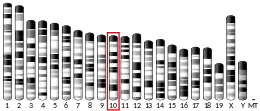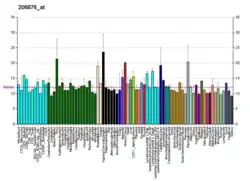SIM1
Single-minded homolog 1 also known as class E basic helix-loop-helix protein 14 (bHLHe14) is a protein that in humans is encoded by the SIM1 gene.[5][6][7]
Function
SIM1 and SIM2 genes are homologs of Drosophila melanogaster single-minded (sim), so named because cells in the midline of the sim mutant embryo fail to properly develop and eventually die, and thus the paired longitudinal axon bundles that span the anterior-posterior axis of the embryo (analogous to the embryo's spinal cord) are collapsed into a "single" rudimentary axon bundle at the midline. Sim is a basic helix-loop-helix-PAS domain transcription factor that regulates gene expression in the midline cells. Since the sim gene plays an important role in Drosophila development and has peak levels of expression during the period of neurogenesis, it was proposed that the human SIM2 gene, which resides in a critical region of chromosome 21, is a candidate for involvement in certain dysmorphic features (particularly facial and skull characteristics), abnormalities of brain development, and/or mental retardation of Down syndrome.[7]
Clinical significance
Haploinsufficiency of SIM1 has been shown to cause severe early-onset obesity in a human girl with a de novo balanced translocation between chromosomes 1p22.1 and 6q16.2 [8] and has been suggested to cause a Prader-Willi-like phenotype in other cases.[9] Additionally, studies in mice have shown that haploinsufficieny of Sim1 causes obesity that is due to hyperphagia and do not respond properly to increased dietary fat.[6][10] Overexpression of SIM1 protects against diet induced obesity and rescues the hyperphagia of agouti yellow mice,[11] who have disrupted melanocortin signaling. The obesity and hyperphagia may be mediated by impaired melanocortin activation of PVN neurons [12] and oxytocin deficiency in these mice.[13] It has been demonstrated that modulating Sim1 levels postnatally also leads to hyperphagia and obesity,[14][15] suggesting a physiological role for Sim1 separate from its role in development.
Interactions
SIM1 has been shown to interact with Aryl hydrocarbon receptor nuclear translocator.[16][17]
References
- GRCh38: Ensembl release 89: ENSG00000112246 - Ensembl, May 2017
- GRCm38: Ensembl release 89: ENSMUSG00000019913 - Ensembl, May 2017
- "Human PubMed Reference:". National Center for Biotechnology Information, U.S. National Library of Medicine.
- "Mouse PubMed Reference:". National Center for Biotechnology Information, U.S. National Library of Medicine.
- Chrast R, Scott HS, Chen H, Kudoh J, Rossier C, Minoshima S, Wang Y, Shimizu N, Antonarakis SE (Jun 1997). "Cloning of two human homologs of the Drosophila single-minded gene SIM1 on chromosome 6q and SIM2 on 21q within the Down syndrome chromosomal region". Genome Research. 7 (6): 615–24. doi:10.1101/gr.7.6.615. PMC 310662. PMID 9199934.
- Michaud JL, Boucher F, Melnyk A, Gauthier F, Goshu E, Lévy E, Mitchell GA, Himms-Hagen J, Fan CM (Jul 2001). "Sim1 haploinsufficiency causes hyperphagia, obesity and reduction of the paraventricular nucleus of the hypothalamus". Human Molecular Genetics. 10 (14): 1465–73. doi:10.1093/hmg/10.14.1465. PMID 11448938.
- "Entrez Gene: SIM1 single-minded homolog 1 (Drosophila)".
- Holder JL, Butte NF, Zinn AR (Jan 2000). "Profound obesity associated with a balanced translocation that disrupts the SIM1 gene". Human Molecular Genetics. 9 (1): 101–8. doi:10.1093/hmg/9.1.101. PMID 10587584.
- Faivre L, Cormier-Daire V, Lapierre JM, Colleaux L, Jacquemont S, Geneviéve D, Saunier P, Munnich A, Turleau C, Romana S, Prieur M, De Blois MC, Vekemans M (Aug 2002). "Deletion of the SIM1 gene (6q16.2) in a patient with a Prader-Willi-like phenotype". Journal of Medical Genetics. 39 (8): 594–6. doi:10.1136/jmg.39.8.594. PMC 1735217. PMID 12161602.
- Holder JL, Zhang L, Kublaoui BM, DiLeone RJ, Oz OK, Bair CH, Lee YH, Zinn AR (Jul 2004). "Sim1 gene dosage modulates the homeostatic feeding response to increased dietary fat in mice". American Journal of Physiology. Endocrinology and Metabolism. 287 (1): E105-13. doi:10.1152/ajpendo.00446.2003. PMID 14982752.
- Kublaoui BM, Holder JL, Tolson KP, Gemelli T, Zinn AR (Oct 2006). "SIM1 overexpression partially rescues agouti yellow and diet-induced obesity by normalizing food intake". Endocrinology. 147 (10): 4542–9. doi:10.1210/en.2006-0453. PMID 16709610.
- Kublaoui BM, Holder JL, Gemelli T, Zinn AR (Oct 2006). "Sim1 haploinsufficiency impairs melanocortin-mediated anorexia and activation of paraventricular nucleus neurons". Molecular Endocrinology. 20 (10): 2483–92. doi:10.1210/me.2005-0483. PMID 16728530.
- Kublaoui BM, Gemelli T, Tolson KP, Wang Y, Zinn AR (Jul 2008). "Oxytocin deficiency mediates hyperphagic obesity of Sim1 haploinsufficient mice". Molecular Endocrinology. 22 (7): 1723–34. doi:10.1210/me.2008-0067. PMC 2453606. PMID 18451093.
- Tolson KP, Gemelli T, Gautron L, Elmquist JK, Zinn AR, Kublaoui BM (Mar 2010). "Postnatal Sim1 deficiency causes hyperphagic obesity and reduced Mc4r and oxytocin expression". The Journal of Neuroscience. 30 (10): 3803–12. doi:10.1523/JNEUROSCI.5444-09.2010. PMC 3285557. PMID 20220015.
- Yang C, Gagnon D, Vachon P, Tremblay A, Levy E, Massie B, Michaud JL (Jun 2006). "Adenoviral-mediated modulation of Sim1 expression in the paraventricular nucleus affects food intake". The Journal of Neuroscience. 26 (26): 7116–20. doi:10.1523/JNEUROSCI.0672-06.2006. PMC 6673926. PMID 16807340.
- Probst MR, Fan CM, Tessier-Lavigne M, Hankinson O (Feb 1997). "Two murine homologs of the Drosophila single-minded protein that interact with the mouse aryl hydrocarbon receptor nuclear translocator protein". The Journal of Biological Chemistry. 272 (7): 4451–7. doi:10.1074/jbc.272.7.4451. PMID 9020169.
- Woods SL, Whitelaw ML (Mar 2002). "Differential activities of murine single minded 1 (SIM1) and SIM2 on a hypoxic response element. Cross-talk between basic helix-loop-helix/per-Arnt-Sim homology transcription factors". The Journal of Biological Chemistry. 277 (12): 10236–43. doi:10.1074/jbc.M110752200. PMID 11782478.
Further reading
- Fan CM, Kuwana E, Bulfone A, Fletcher CF, Copeland NG, Jenkins NA, Crews S, Martinez S, Puelles L, Rubenstein JL, Tessier-Lavigne M (Jan 1996). "Expression patterns of two murine homologs of Drosophila single-minded suggest possible roles in embryonic patterning and in the pathogenesis of Down syndrome". Molecular and Cellular Neurosciences. 7 (1): 1–16. doi:10.1006/mcne.1996.0001. PMID 8812055. S2CID 11411254.
- Probst MR, Fan CM, Tessier-Lavigne M, Hankinson O (Feb 1997). "Two murine homologs of the Drosophila single-minded protein that interact with the mouse aryl hydrocarbon receptor nuclear translocator protein". The Journal of Biological Chemistry. 272 (7): 4451–7. doi:10.1074/jbc.272.7.4451. PMID 9020169.
- Holder JL, Butte NF, Zinn AR (Jan 2000). "Profound obesity associated with a balanced translocation that disrupts the SIM1 gene". Human Molecular Genetics. 9 (1): 101–8. doi:10.1093/hmg/9.1.101. PMID 10587584.
- Hartley JL, Temple GF, Brasch MA (Nov 2000). "DNA cloning using in vitro site-specific recombination". Genome Research. 10 (11): 1788–95. doi:10.1101/gr.143000. PMC 310948. PMID 11076863.
- Woods SL, Whitelaw ML (Mar 2002). "Differential activities of murine single minded 1 (SIM1) and SIM2 on a hypoxic response element. Cross-talk between basic helix-loop-helix/per-Arnt-Sim homology transcription factors". The Journal of Biological Chemistry. 277 (12): 10236–43. doi:10.1074/jbc.M110752200. PMID 11782478.
- Faivre L, Cormier-Daire V, Lapierre JM, Colleaux L, Jacquemont S, Geneviéve D, Saunier P, Munnich A, Turleau C, Romana S, Prieur M, De Blois MC, Vekemans M (Aug 2002). "Deletion of the SIM1 gene (6q16.2) in a patient with a Prader-Willi-like phenotype". Journal of Medical Genetics. 39 (8): 594–6. doi:10.1136/jmg.39.8.594. PMC 1735217. PMID 12161602.
- Yamaki A, Kudoh J, Shimizu N, Shimizu Y (Jan 2004). "A novel nuclear localization signal in the human single-minded proteins SIM1 and SIM2". Biochemical and Biophysical Research Communications. 313 (3): 482–8. doi:10.1016/j.bbrc.2003.11.168. PMID 14697214.
- Meyre D, Lecoeur C, Delplanque J, Francke S, Vatin V, Durand E, Weill J, Dina C, Froguel P (Mar 2004). "A genome-wide scan for childhood obesity-associated traits in French families shows significant linkage on chromosome 6q22.31-q23.2". Diabetes. 53 (3): 803–11. doi:10.2337/diabetes.53.3.803. PMID 14988267.
- Kublaoui BM, Holder JL, Tolson KP, Gemelli T, Zinn AR (Oct 2006). "SIM1 overexpression partially rescues agouti yellow and diet-induced obesity by normalizing food intake". Endocrinology. 147 (10): 4542–9. doi:10.1210/en.2006-0453. PMID 16709610.




